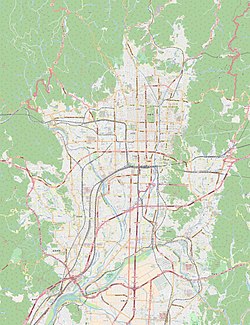Kyoto Railway Museum
Kinh đô thiết đạo bác vật quán | |
 The museum entrance in October 2016 | |
Former name | Umekoji Steam Locomotive Museum |
|---|---|
| Established |
|
| Location | Shimogyō-ku, Kyoto,Japan |
| Coordinates | 34°59′14″N135°44′33″E/ 34.98722°N 135.74250°E |
| Type | Railway museum |
| Owner | JR West |
| Public transit access | Umekōji-Kyōtonishi Station,JR WestSagano Line |
| Nearest car park | Umekoji Park |
| Website | www |
TheKyoto Railway Museum(Kinh đô thiết đạo bác vật quán,Kyōto Tetsudō Hakubutsukan)(formerly theUmekoji Steam Locomotive Museum(Mai tiểu lộ chưng khí cơ quan xa quán,Umekōji Jōkikikansha-kan)until 2016) is arailway museuminShimogyō-ku, Kyoto,Japan. The original Umekoji Steam Locomotive Museum opened in 1972, but was expanded and modernized in 2016, becoming the Kyoto Railway Museum.
The museum is owned byWest Japan Railway Company(JR West) and is operated by Transportation Culture Promotion Foundation.
Exhibition zones[edit]
The museum is divided into the following exhibition areas, including the 20-trackroundhousebuilt in 1914.
- Promenade
- Main Hall
- Twilight Plaza
- Roundhouse
- FormerNijō Station
-
The Promenade area in May 2016
Main Hall[edit]
This is a three-storey building completed in April 2016.[1]
-
Exhibits in the main hall in May 2016
-
The Main Hall viewed from the second floor in May 2016
Roundhouse[edit]

The 1914 roundhouse was built surrounding aturntable.It is anImportant Cultural Propertydesignated by the government of Japan as the oldest reinforced-concrete car shed extant in Japan.[2]
-
The roundhouse in May 2016
Former Nijo Station[edit]

This two-storey structure was formerly part ofNijō Stationin Kyoto until March 1996, and was subsequently moved to the Umekoji Steam Locomotive Museum where if formed the entrance building, housing the museum shop.[1]
-
The former Nijo Station building in February 2006
Exhibits[edit]
As of April 2016[update]a total of 53 rolling stock items are on display at the museum.[3][1]
Steam locomotives[edit]

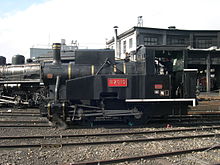



| Type | Number | Manufacturer | Year built | Exhibition area |
|---|---|---|---|---|
| JGR Class 7100 | 7105 | HK Porter(USA) | 1880 | Roundhouse |
| JGR Class 1800 | 1801 | Kitson & Company(UK) | 1881 | Main hall |
| JGR Class 1070 | 1080 | Dübs & Company(UK) | 1901 | Roundhouse |
| JGR Class 230 | 233 | Kisha Seizo | 1903 | Main hall |
| JGR Class 8620 | 8630 | Kisha Seizo | 1914 | Roundhouse |
| JNR Class 9600 | 9633 | Kawasaki | 1914 | Roundhouse |
| JNR Class D50 | D50 140 | Hitachi | 1926 | Roundhouse |
| JNR Class C51 | C51 239 | Kisha Seizo | 1927 | Roundhouse |
| JNR Class C53 | C53 45 | Kisha Seizo | 1928 | Roundhouse |
| JNR Class C11 | C11 64 | Kawasaki | 1935 | Roundhouse |
| JNR Class C55 | C55 1 | Kawasaki | 1935 | Roundhouse |
| JNR Class D51 | D51 1 | Kawasaki | 1936 | Roundhouse |
| JNR Class C57 | C57 1 | Kawasaki | 1937 | Roundhouse |
| JNR Class D51 | D51 200 | JNR Hamamatsu | 1938 | Roundhouse |
| JNR Class C58 | C58 1 | Kisha Seizo | 1938 | Roundhouse |
| JNR Class C56 | C56 160 | Kawasaki | 1939 | Roundhouse |
| JNR Class B20 | B20 10 | Tateyama | 1946 | Roundhouse |
| JNR Class D52 | D52 468 | Mitsubishi | 1946 | Roundhouse |
| JNR Class C59 | C59 164 | Hitachi | 1946 | Roundhouse |
| JNR Class C62 | C62 1 | Hitachi | 1948 | Roundhouse |
| JNR Class C62 | C62 2 | Hitachi | 1948 | Roundhouse |
| JNR Class C61 | C61 2 | Mitsubishi | 1948 | Roundhouse |
| JNR Class C62 | C62 26 | Kawasaki | 1948 | Promenade |
Diesel locomotives[edit]
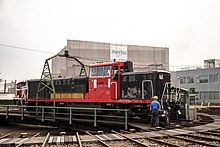
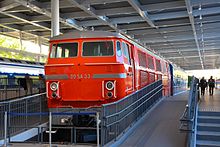
| Type | Number | Manufacturer | Year built | Exhibition area | Remarks |
|---|---|---|---|---|---|
| Class DD54 | DD54 33 | Mitsubishi | 1971 | Promenade | |
| Class DD51 | DD51 756 | Hitachi | 1972 | Main hall | |
| Class DE10 | DE10 1156 | Hitachi | 1972 | Promenade | |
| Class 912 | 912-63 | Main hall | Front end only |
Electric locomotives[edit]
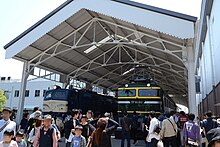
| Type | Number | Manufacturer | Year built | Exhibition area | Remarks |
|---|---|---|---|---|---|
| Class EF52 | EF52 1 | Hitachi | 1928 | Main Hall | Brown livery |
| Class EF58 | EF58 150 | Tokyo Shibaura Denki | 1958 | Twilight Plaza | Blue livery |
| Class EF65 | EF65 1 | Kawasaki | 1965 | Twilight Plaza | Blue livery |
| Class EF81 | EF81 103 | Hitachi | 1974 | Twilight Plaza | Twilight Expressgreen livery |
| Class EF66 | EF66 35 | Toyo Denki/Kawasaki | 1974 | Main Hall | Blue livery |
Shinkansen[edit]
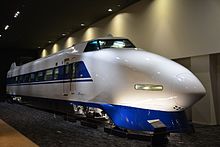
| Type | Number | Manufacturer | Year built | Exhibition area |
|---|---|---|---|---|
| 0 series | 21-1 | Nippon Sharyo | 1964 | Promenade |
| 0 series | 16-1 | Nippon Sharyo | 1964 | Promenade |
| 0 series | 35-1 | Nippon Sharyo | 1964 | Promenade |
| 0 series | 22-1 | Nippon Sharyo | 1964 | Promenade |
| 100 series | 122-5003 | Hitachi | 1989 | Main Hall |
| 500 series | 521-1 | Kawasaki Heavy Industries | 1996 | Main Hall |
EMUs[edit]

| Type | Number | Manufacturer | Year built | Exhibition area | Remarks |
|---|---|---|---|---|---|
| 80 series | KuHa 86001 | Hitachi | 1950 | Promenade | Orange/greenShonanlivery |
| 80 series | MoHa 80001 | Hitachi | 1950 | Promenade | Orange/greenShonanlivery |
| 103 series | KuHa 103-1 | Nippon Sharyo | 1963 | Promenade | Vermillion orange livery |
| 581 series | KuHaNe 581-35 | Hitachi | 1968 | Main Hall | |
| 489 series | KuHa 489-1 | Tokyu Car | 1971 | Main Hall |
DMUs[edit]

| Type | Number | Manufacturer | Year built | Exhibition area |
|---|---|---|---|---|
| KiHa 81 series | KiHa 81-3 | Kinki Sharyo | 1960 | Main Hall |
Coaches[edit]

| Type | Number | Manufacturer | Year built | Exhibition area | Remarks |
|---|---|---|---|---|---|
| SuShi 28 | SuShi 28 301 | Nippon Sharyo | 1933 | Promenade | Brown livery |
| MaRoNeFu 59 | MaRoNeFu 59 1 | Kisha Seizo | 1955 | Main Hall | Brown livery |
| OHa 46 | OHa 46 13 | Nippon Sharyo | 1933 | Promenade | Brown livery |
| 20 series | Nashi 20 24 | Nippon Sharyo | 1970 | Promenade | Blue livery |
| 24 series | ORoNe 24 4 | Hitachi | 1972 | Twilight Plaza | Blue livery |
| 50 series | OHaFu 50 68 | Niigata Engineering(also known as Niigata Tekko) | 1977 | Roundhouse | Red livery |
| 24 series | Sushi 24-1 | 1988 | Twilight Plaza | Twilight Expresslivery | |
| 24 series | SuRoNeFu 25-501 | 1989 | Twilight Plaza | Twilight Expresslivery | |
| 24 series | OHa 25-551 | 1989 | Main Hall | Twilight Expresslivery | |
| 24 series | KaNi 24-12 | 1975 | Main Hall | Twilight Expresslivery |
Freight wagons[edit]

| Type | Number | Manufacturer | Year built | Exhibition area | Remarks |
|---|---|---|---|---|---|
| WaMu 3500 | WaMu 7055 | Nippon Sharyo | 1917 | Main Hall | Black livery |
| Yo 5000 | Yo 5008 | Kawasaki Sharyo | 1959 | Main Hall | Light green livery |
History[edit]
As early as 1967 plans were being made to make the round-house at Umekoji depot, Kyoto into a live museum where good-order examples of Japanese steam locomotives could be displayed and also steamed and run. The Opening-eve ceremony was held on October 9th 1972 from 1:00 p.m. At the beginning, JNR president Mr. Isozaki planted a memorial youngblack pine tree.The opening ceremony was conducted in front of the Symbol-Zone. The ceremony invited the Kyoto prefectural governor, Kyoto city mayor, and successive Umekoji depot directors, and one hundred and thirty other celebrities as well as eighty JNR members. After the JNR president's congratulatory speech, the naming ceremony was done. It was named "The Umekoji Steam Locomotive Museum (Umekoji Jyoki Kikansha Kan)." The dedicated monument embodied the driving wheel from a C57 88 (Retired at 1st May 1972). There is an original English epitaph on the monument, as follows;
May the glory of steam locomotives over the past century be remembered and their gallant sight preserved here forever.
10 October 1972 Japan National Railways.
At the end of the ceremony, a special ceremonial train was run by the C62 2. The museum was opened byJapanese National Railways(JNR) on October 10, 1972 commemorating the centennial of the railway in Japan.[4]When JNR was divided into regional companies in 1987, the museum was inherited byJR West.
Expansion plans[edit]
On 19 December 2012, JR West officially announced its plans to modernize and expand the Umekoji museum.[5]It was announced on 18 December 2013 that the enlarged museum would be renamed the Kyoto Railway Museum.[6]The construction cost was 7.0 billion yen.[7][5]
Once the expansion was complete, the new museum exhibit space covered 31,000 square meters, becoming the largest railway museum in Japan both in terms of floor space and the number of trains exhibited, and surpassing JR East'sRailway MuseuminSaitamaand JR Central'sSCMaglev and Railway ParkinNagoya.
The expansion became necessary due to the aging facilities of theModern Transportation MuseuminOsaka.The Modern Transportation Museum closed on 6 April 2014, and the exhibits housed there were subsequently moved to the new railway museum in Kyoto.[8]
Access[edit]
The museum is approximately 3 minutes on foot fromUmekōji-Kyōtonishi Station.
See also[edit]
- JR EastRailway Museum,Saitama,Saitama Prefecture
- JR CentralSCMaglev and Railway Park,Nagoya,Aichi Prefecture
References[edit]
- ^abcKinh đô thiết đạo bác vật quán[Kyoto Railway Museum].Japan Railfan Magazine(in Japanese). Vol. 56, no. 662. Japan: Koyusha Co., Ltd. June 2016. pp. 26–77.
- ^Official website of the museumArchived2009-09-01 at theWayback Machine.Retrieved on August 29, 2009.(in Japanese)
- ^Kinh đô thiết đạo bác vật quán の khái yếu[Overview of the Kyoto Railway Museum].Tetsudō Daiya Jōhō Magazine(in Japanese). Vol. 45, no. 385. Japan: Kōtsū Shimbun. May 2016. pp. 12–34.
- ^Japan Railfan MagazineOctober 1993 issue, p. 20
- ^ab2016 niên ( bình thành 28 niên ) xuân, kinh đô ・ mai tiểu lộ エリアに tân たな thiết đạo bác vật quán が khai nghiệp します[New railway museum to open in Kyoto/Umekoji area in spring 2016].Press release(in Japanese). West Japan Railway Company. 19 December 2012. Archived fromthe originalon 19 January 2013.Retrieved19 December2013.
- ^Thiết đạo bác vật quán の danh xưng が quyết まりました[Railway museum name fixed].Press release(in Japanese). Japan: West Japan Railway Company. 18 December 2013.Retrieved19 December2013.
- ^Kinh đô ・ mai tiểu lộ エリアに tân たな thiết đạo bác vật quán[New railway museum for Umekoji, Kyoto].Japan Railfan Magazine Online(in Japanese). Japan: Koyusha Co., Ltd. 20 December 2012.Retrieved20 December2012.
- ^52 niên phân の cảm tạ と cộng に, giao thông khoa học bác vật quán の営 nghiệp を chung liễu します[Modern Transportation Museum to close after 52 years].Press release(in Japanese). West Japan Railway Company. 24 July 2013.Retrieved13 August2013.
Further reading[edit]
- Kinh đô thiết đạo bác vật quán のすべて[Complete Guide to the Kyoto Railway Museum] (in Japanese). Japan: JTB Publishing. 20 April 2016.ISBN978-4533110726.

